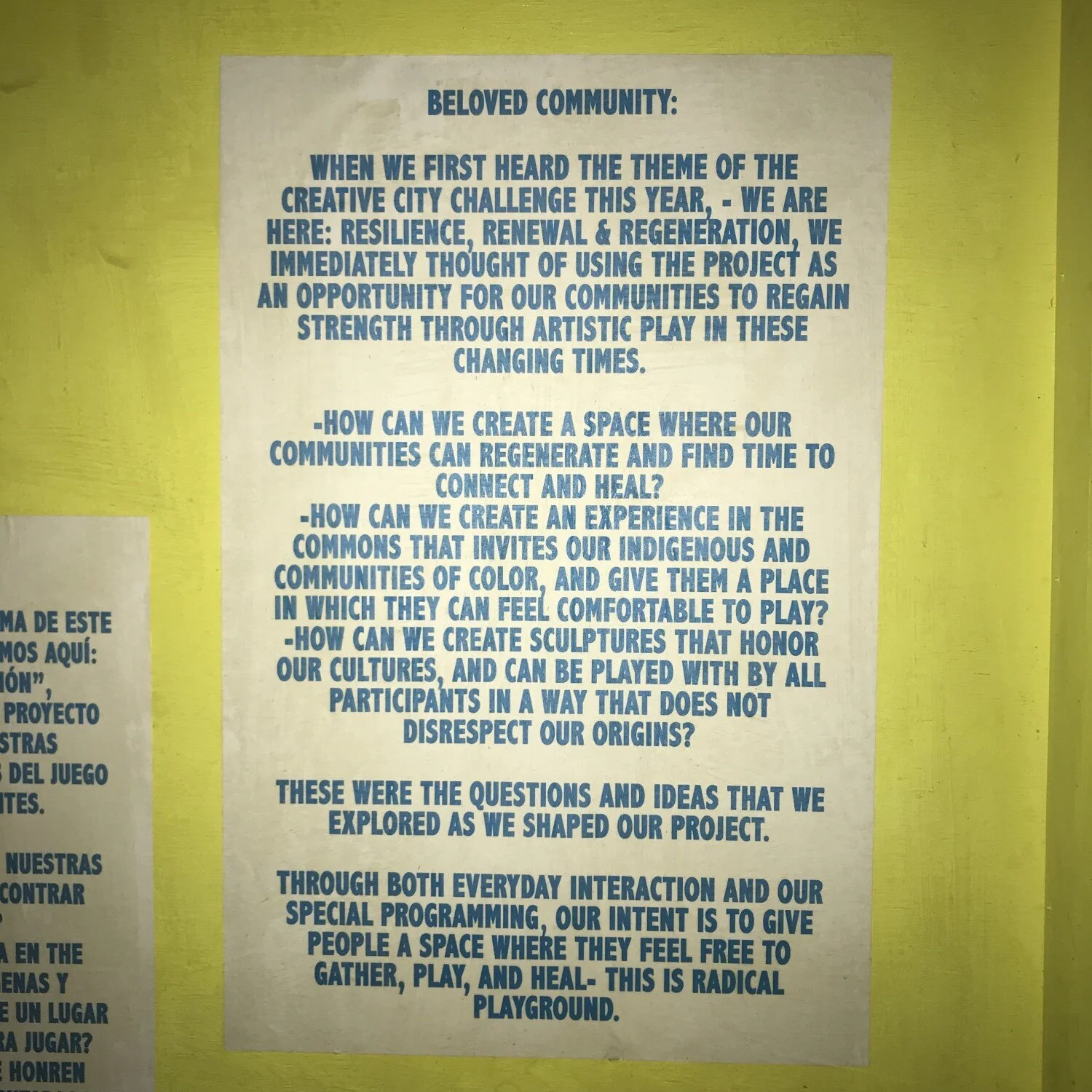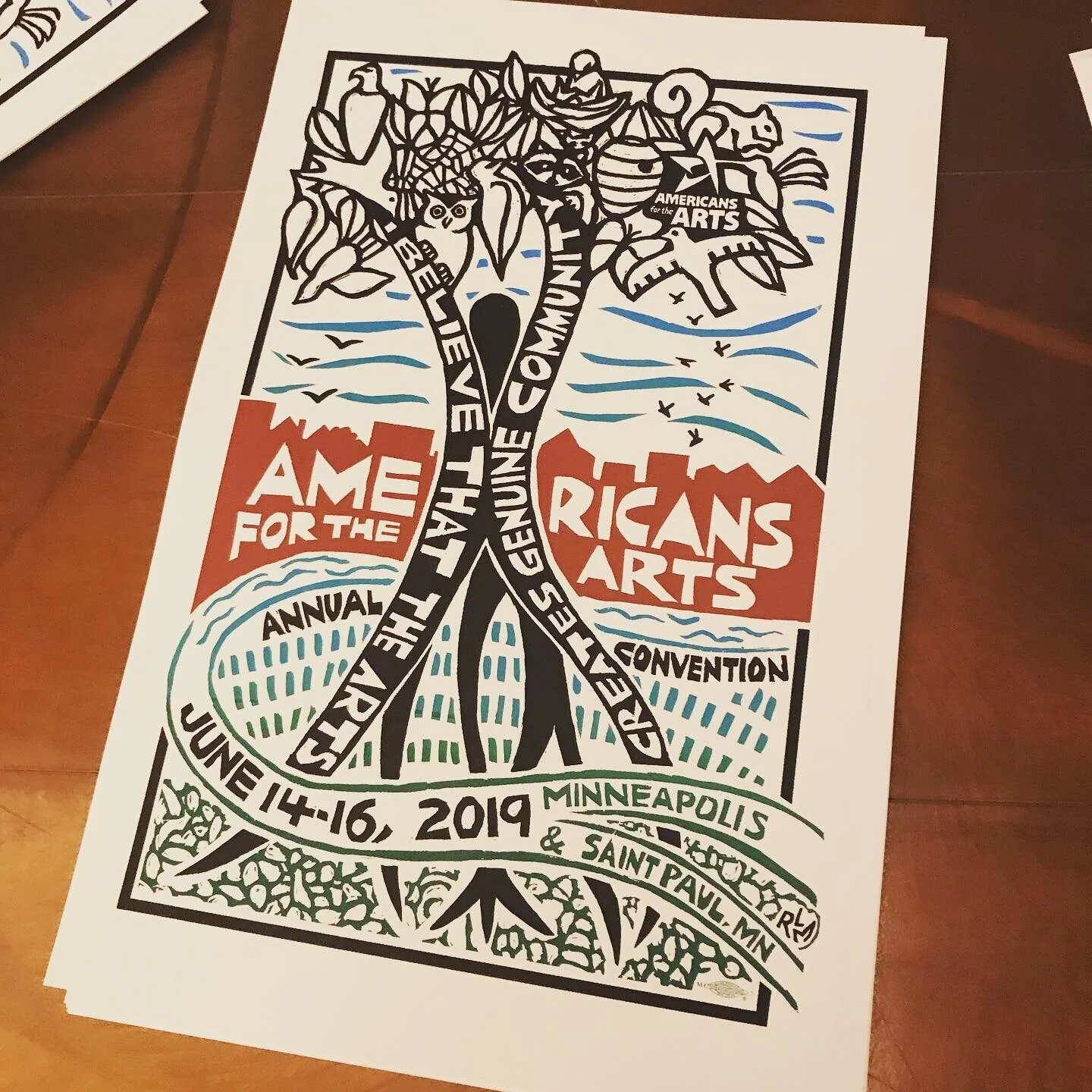Art is who we are, cities are what we do
Mike Bishop, Leslie Barlow, and Tricia Heuring speak about Studio 400.
I started writing this on Sunday night, in a blur of fading adrenaline and bodily exhaustion, thinking with gratitude over the events that had just take place over the past week. Over the weekend, the Twin Cities had hosted the Americans for the Arts Convention (AFTACON), bringing 1,000 arts and culture leaders from around the country and Canada to the Twin Cities. I was honored to organize the local host committee along with the City of Minneapolis Office of Arts, Culture & the Creative Economy, working with artists, arts leaders, government officials, and marketing folks from the Twin Cities. We dovetailed AFTACON to take place along with the Northern Spark festival, and the launch of Radical Playground at The Commons, hired artists to be on the convention site, put together an artists market, and organized themed tours throughout the metro. It was riotous, joyful, exhausting, and showed not just who we are here in the Twin Cities, but a heightened expectation of what we can be when we work together.
Part of what made the event such a smash for me was the ability to bring AFTACON here on the nights of Northern Spark. Northern Spark has always been one of my favorite events of the year, an opportunity to literally see the city in a new light. I've had to miss several iterations, though, because it tends to fall on the same Father's Day weekend as the convention. This time, though, people were coming to us, and we were able to plan the official opening reception for AFTACON to lead right into the launch of Northern Spark.
That meant that we walked hundreds of folks from all over the country to The Commons, where they ate local snacks from places like the Red Stag Supper Club and Afro Deli, drank local beers and sodas, and soaked in a perfect Minnesota June evening while art and music happened all around them. "People are changing their opinions of Minneapolis right now," one of the AFTA staffers turned to me and said – and it wasn't hard to see why. If the dominant narrative of a place is that it is white, subdued, and constrained, to be outdoors, listening to Somali music, drinking beers, at the launch of a late-night party and a public art installation that draws inspiration and power from Mexican, Azteca, and indigenous traditions, that can be a welcome shock to the system. It's one we should embrace as Minnesotans.
The theme of AFTACON was "Genuine Community" and instead of simply taking the theme as a given, I am enormously grateful for the local host committee, and especially the small group of Kathy Mouacheupao, Lann Briel, Justin Christy, MaryAnne Quiroz, Sarah Peters, Mary Delorié, and myself, who had the opportunity to dig into what "genuine community" really means to us right now. Through conversations and brainstorming, we landed on a set of values that helped guide the decision-making for the rest of the convention, that for us, "genuine community" meant work and ways of being that are multi-disciplinary, inter-generational, fostering self-expression, respectful, gracious, imbued with gratefulness and reciprocity, inviting dialogue that is not just talking to but talking among, makes space for discord and acknowledges that inviting conflicting views is okay, and enables resiliency.
Those values speak to a place that is vibrant, working on healing traumas, and making space for many voices. A recent CityLab article asked why Americans don't use their parks at night, citing international examples and select U.S.-based initiatives to highlight the social benefits around using the parks late. The Minneapolis parks system is much lauded, and it is beautiful green space, but we need it to be beautiful social space. We have some of the highest racial disparities in the country, and when I think about all our great benefits – parks systems, strong civic and nonprofit sector, world-class museums – I do have to remind myself that these systems were all built in a much whiter Minnesota. In 1980, 96% of the state was white. We are barely a generation into meaningful demographic change in this state, it's no wonder that we have so much to do, so far to go to reimagine our support systems.
That set of values is what made the Radical Playground launch so exciting to have at the same time as AFTA, and I believe is an important re-framing of who we are and can be. For me, it called to mind a critical essay from activist and organizer Roberto Bedoya, who received the Public Art Network Award from AFTA at the convention. In his 2014 essay, "Spatial Justice: Rasquachification, Race and the City" Bedoya cites the colorful, recycled designs of the Chicano neighborhoods he grew up in as a means of establishing visibility and community identity in a space where it would otherwise be erased. The theme of Northern Spark, "We are here," and the pillars of Radical Playground emblazoned with the phrase in many languages, could not be a more perfect fit. Estamos aquí, Radical Playground says, with its brightness and oversized alebrijes, a public space that expands imagination beyond whiteness. As Bedoya writes:
"Rasquachification messes with the white spatial imaginary and offers up another symbolic culture—combinatory, used and reused. The Rasquache spatial imaginary is the culture of lowriders who embrace the street in a tempo parade of coolness; it’s the roaming dog that marks its territory; it’s the defiance signified by a bright, bright, bright house; it’s the fountain of the peeing boy in the front yard; it’s the DIY car mechanic, leather upholsterer or wedding-dress maker working out of his or her garage with the door open to the street; it’s the porch where the elders watch; and it’s the respected neighborhood watch program. Rasquachification challenges America’s deep racial divide through acts of ultravisibility undertaken by those rendered invisible by the dominant ideology of whiteness."
We also continued to ask ourselves how the presence of a short-term conference could benefit us in the long term. The act of having these conversations and organizing together is one of those benefits. Those decisions around our values led to the hiring of artists who are advocates ad community builders, and amongst the convention itself, almost exclusively women and artists of color. We were fortunate enough to have our guests experience the talents of Dessa and Aby Wolf, the Little Earth Singers, In the Heart of the Beast Puppet and Mask Theater, Ananya Dance Theatre, contemporary Hmong fashion curated by the SA | KO Collective, contemporary Anishinaabe designs from Delina White, Gaelynn Lea, and Ifrah Mansour. And to highlight Radical Playground, and the Franklin Avenue node of Northern Spark with it's emphasis on Native American artists, and in Rondo at the Hallie Q. Brown Center, and that African-American history, that felt like who we really are now, and who we can aspire to be together.
Part of the benefit of working with the local host committee was also the ability to bring people out on tours all around the Cities. We had Prince tours, went to the West Bank, Northside, Bloomington, St. Paul and spots in between, highlighting literature, food, and creative partnerships all over. Over 3 hours, visitors got to meet artists, see spaces that they otherwise might not have seen on a visit, and connect meaningfully around the work. It's a model of cultural tourism and visiting that could be adopted and adapted by organizations like Meet Minneapolis, Visit St. Paul, and GreaterMSP to great effect – get visitors really behind the scenes, and don't just leave to people's AirBnB experience offerings.
I was lucky enough to put together a tour of artist-run spaces in Northeast Minneapolis, in partnership with Councilmember Kevin Reich. We visited Studio 400, the new project in the Northrup King Building from Public Functionary, the Flux Arts Building, recently purchased by an artist partnership, and Water Bar, the social practice and community space, where we were greeted by Amoke Kubat of Yo Mama's House. On the tour leaders of arts councils, people from around the country who work closely local government, and in development. They were both in awe and jealous of the nonprofit support in Minnesota, which is true of just about any visitor from the U.S., but also questioning about other areas of our offerings – What ordinance and policy systems do we have to support keeping artists in place? Why don't the arts get a portion of the hotel tax? What other systems are there for arts district designation? What kind of joint marketing is offered? These, as I've written before, are pressing questions, and I was grateful to have a Councilmember hear them.
I also had a moment of realization while on the tour that for all our vaunted nonprofit support, all three of the sites we visited were incorporated as LLCs, or had some blended model. What is it, then, that we might be missing in our foundation and government support? How are we able to look at the work we do and the impact we want, instead of using a tax designation as a proxy for viability? What are we doing now to open up systems of funding to the work as it exists on the ground? I was able to speak with AFTA's Emerging Leaders Council on Thursday, and highlighted Springboard's Incubator Fiscal Sponsorship program, and the board resource we recently created with Propel Nonprofits. The reaction showed that we are already ahead of other states in Minnesota, but let's not rest on that. If this past weekend – and the 18 months of organizing that led up to it – grounded anything for me, it's that we have so much here, and it is our future to share it, to build it together.
The convention really was a blast. I can't tell you a thing about any of the sessions, because I never got to one, or saw a full keynote either. There was always more work to do. Ask me about mannequins sometime. The keynotes should be up on AFTA's YouTube channel soon, and I look forward to watching them, but I'll go back to the well that is the #AFTACON hashtag on Twitter and Instagram for inspiration, critical questions, and the real time joy of people discovering our cities.
And I'll go back to the well that was this local host committee. Huge thanks go to Gülgün Kayim, Kevin Reich, Bill Deef, Ben Owen, Meena Mangalvedhekar, Sarah Peters, Scott Mayer, MaryAnne Quiroz, Kathy Mouacheupao, Colleen Sheehy, Dameun Strange, Mary Delorié, Theresa Sweetland, Katherine Smith-Flores, Eric Anderson, Alejandra Pelinka, Justin Christy, Sheila Smith, Joanna Schnedler, Matt Lewis, Andrea Jenkins, Lann Briel, Peter Leggett, Nora Riemenschneider, Felicia Perry, Sarah Lovan, and Joan Vorderbruggen. You're such champs, for our artists, for our cities. Thank you.


